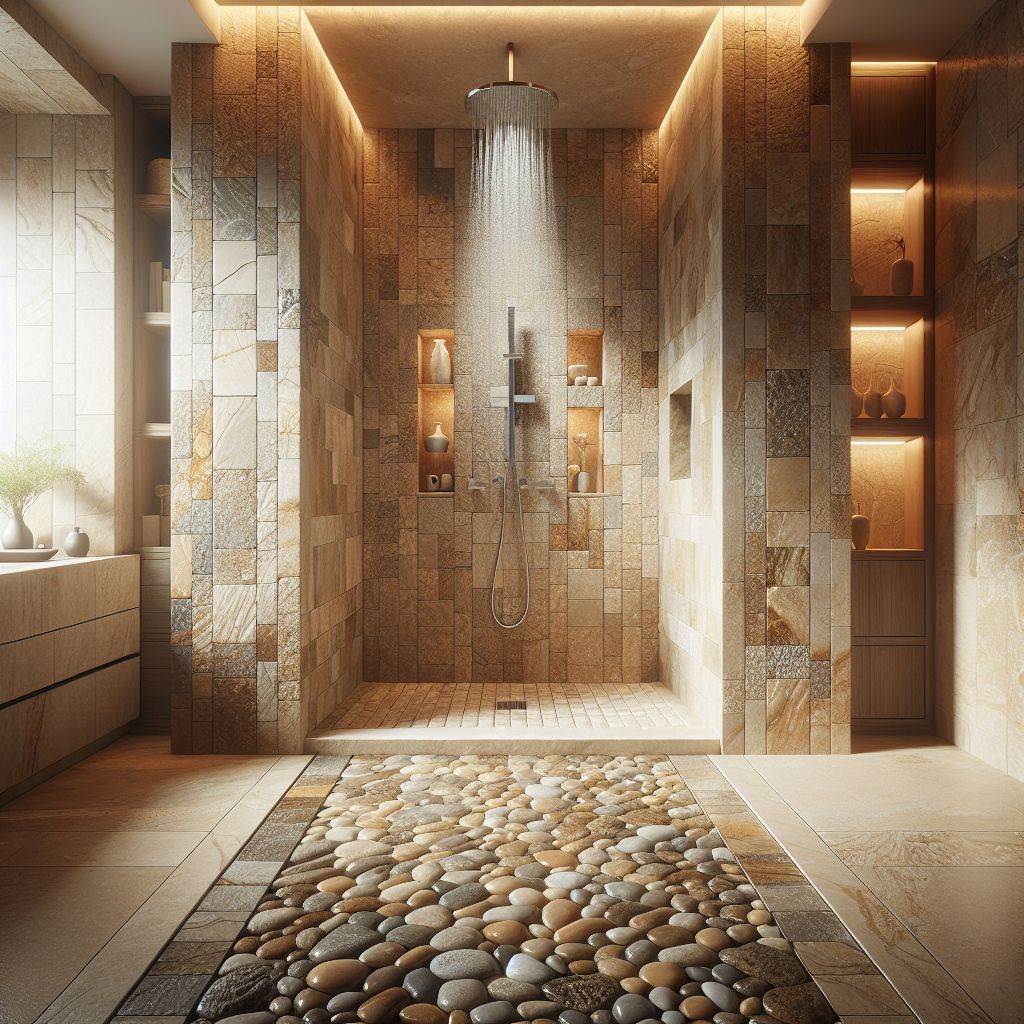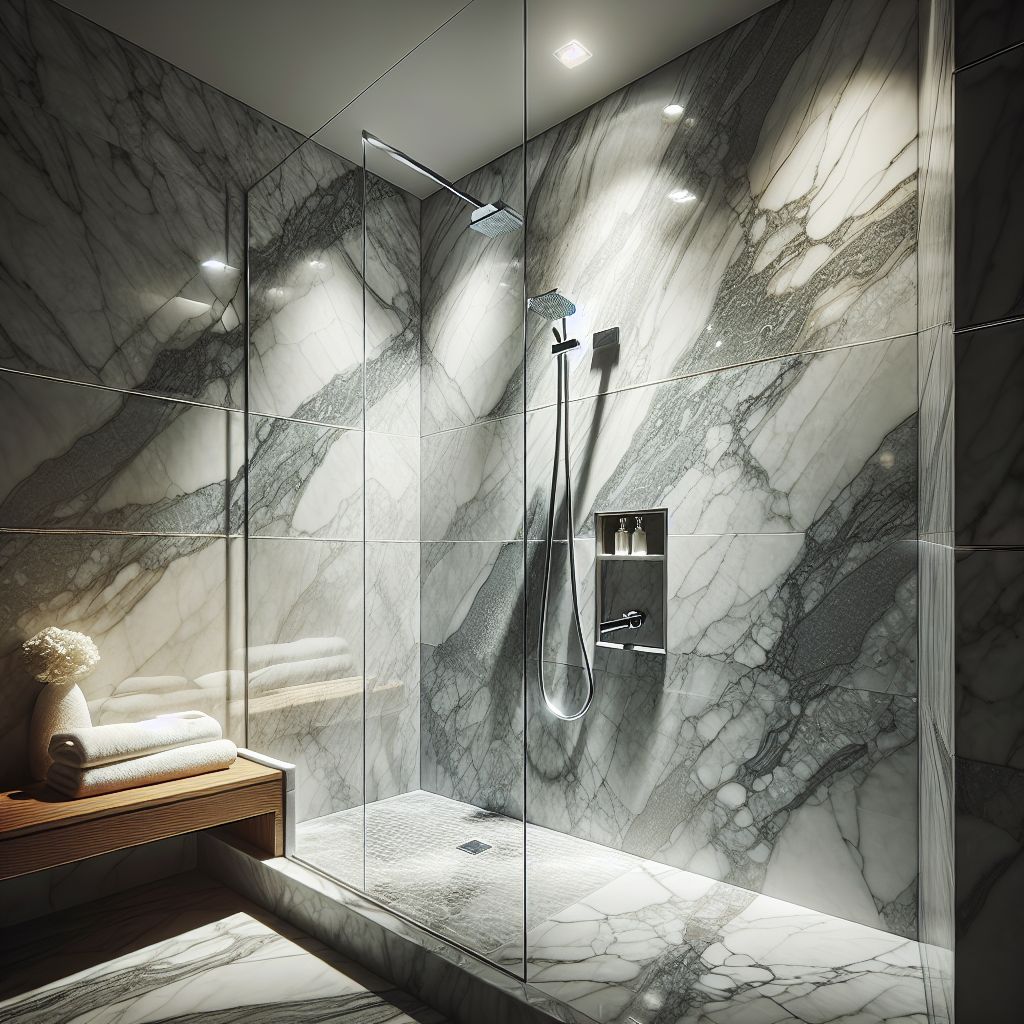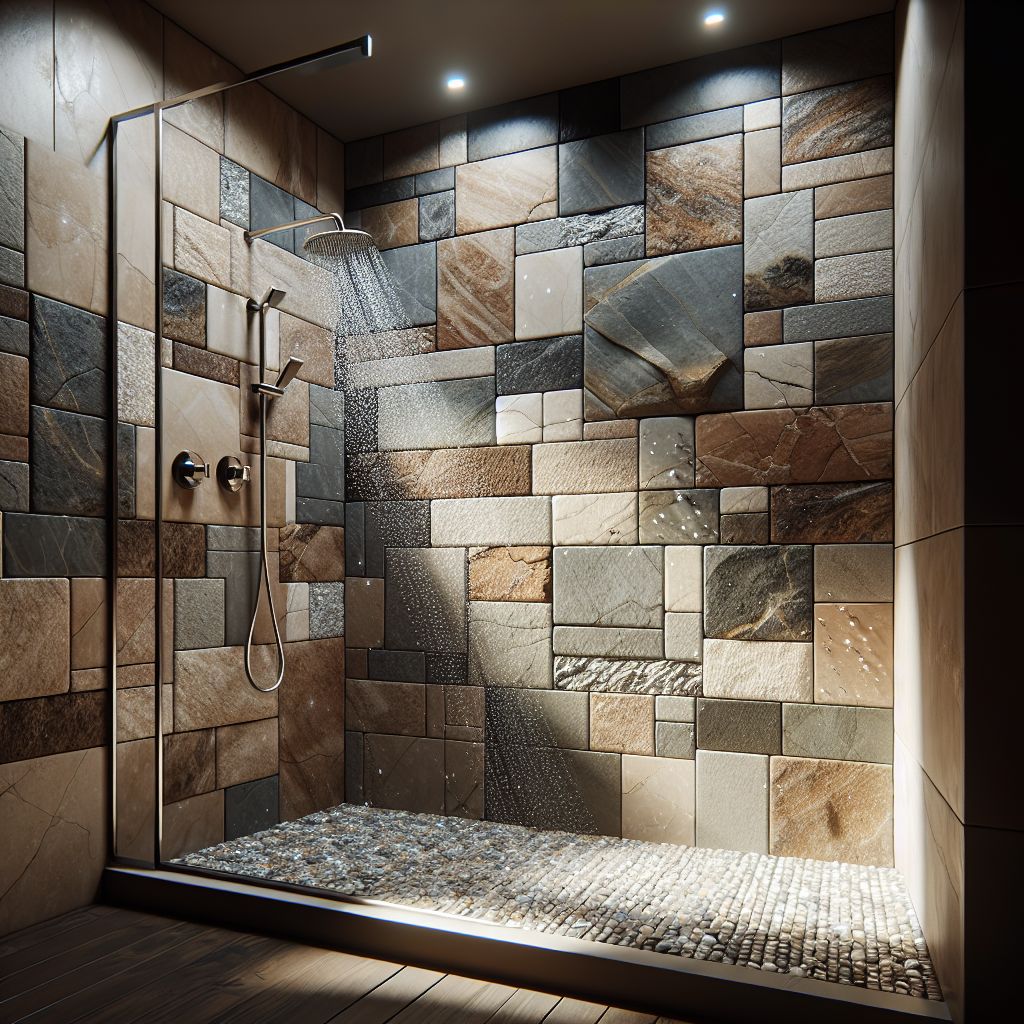
Key Takeaways
-
Natural stone shower tiles can be either refinished or fully remodeled, each with its own set of benefits.
-
Refinishing is cost-effective and can extend the life of your existing tiles without a complete overhaul.
-
Remodeling provides a completely new look and can increase your home’s value, but it comes with higher costs and a longer timeline.
-
Understanding the specifics of your bathroom’s structure and your own preferences is critical before deciding between refinishing and remodeling.
-
Regular maintenance is key to preserving the beauty of natural stone tiles, whether you choose to refinish or remodel.
Revive or Redo: Making Smart Choices for Shower Tiles
When it comes to sprucing up your bathroom, the shower area is a focal point that demands attention. The walls adorned with tiles not only protect from moisture but also contribute to the overall aesthetic. If you’re facing the dilemma of whether to give those natural stone shower tiles a facelift or go for a complete redo, you’re in the right place. Let’s dive into the nitty-gritty of both options so you can make an informed decision that aligns with your goals and budget.
Snap Comparison: Refinishing vs Remodeling Natural Stone Shower Tiles
| Refinishing | Remodeling | |
| Cost | $200 to $500 | $1,000 to $5,000 |
| Timeline | 1 to 2 days | Several weeks |
| Pros | Cost-effective, quick turnaround time, minimal disruption | Complete customization, increases home value, fixes underlying issues |
| Cons | Limited customization, temporary fix | Extensive process, disruptive, time-consuming |
Understanding Refinishing
Refinishing, also known as reglazing, is a process where your existing tiles are cleaned, repaired, and coated with new paint or finishing material. It’s a great way to refresh your bathroom’s look without the need for extensive construction. Think of it as giving your shower a new outfit rather than altering its body.
-
Begin with a thorough cleaning to remove any mold, mildew, or soap scum.
-
Next, repair any chips or cracks to ensure a smooth surface.
-
Finally, apply a high-quality sealant or glaze to give your tiles a brand-new shine.
Refinishing is especially suitable when your tiles are still in good shape but have lost their luster over the years. It’s also a quick fix, usually taking only a couple of days, and it won’t leave your bathroom out of commission for too long.
Grasping the Full Scope of Remodeling
On the other hand, remodeling means starting from scratch. This involves removing the old tiles, preparing the surface, and installing new ones. It’s a more extensive project that allows for complete customization of your space. Remodeling is the way to go if you’re looking to change the layout, size, or design of your shower area.

Cost Comparison: Refinishing vs. Remodeling
When you’re contemplating the future of your shower space, cost is a significant factor. Refinishing might have a lower upfront cost, often ranging between $200 to $500, depending on the size of your shower and the condition of your tiles. Remodeling, however, can set you back anywhere from $1,000 to over $5,000, influenced by the choice of materials, labor, and any additional structural changes.
It’s important to consider not just the immediate expenses but also the long-term investment you’re making into your home. While refinishing is easier on the wallet now, remodeling could potentially increase your home’s value and appeal to future buyers.
Breaking Down Refinishing Expenses
Let’s take a closer look at what goes into the cost of refinishing your shower tiles:
-
Materials: High-quality coatings and sealants are essential for a durable finish.
-
Labor: Skilled professionals should perform the refinishing to ensure longevity.
-
Repairs: Any prior damage to the tiles needs to be addressed before the refinishing can take place.
While these expenses are relatively modest, they are necessary to ensure that your refinishing project is successful and lasting. If you’re hiring a professional to handle the refinishing, all the above costs should be included in their quote.
Remodeling Costs: Short-Term and Long-Term
For a full remodeling project, the expenses can be broken down as follows:
|
Expense |
Cost Range |
|---|---|
|
Demolition and Removal |
$200 – $500 |
|
New Tiles |
$5 – $50 per square foot |
|
Labor |
$10 – $20 per square foot |
|
Additional Materials |
Varies |
Remember, the long-term cost also includes maintenance and the potential increase in home value. High-quality natural stone tiles, when properly installed and maintained, can last for decades and become a standout feature in your home.
Cost-Effectiveness Over Time
Refinishing might seem like the more economical choice initially, but consider the frequency of redoing the finish. A refinished surface might need attention every 5-10 years, depending on usage and care. In contrast, a well-executed remodel can last much longer, potentially making it more cost-effective over time, depending on wear and tear.
Assessing Time and Effort Investment
Another critical aspect to consider is the investment of time and effort. Refinishing is relatively quick and can often be completed within a day or two. This means your bathroom will be back in action without much downtime.
Quick Fix: The Speed of Refinishing
Refinishing is akin to a weekend makeover for your bathroom. It’s a swift process that yields results fast, making it an ideal choice for those who need a speedy solution.
However, speed comes with its trade-offs. The rapid turnaround time means there’s less room for customization, and you’re working within the constraints of your current tile layout and design.
Remodeling Timeline: From Planning to Perfection
Remodeling is a more extensive process, typically taking several weeks to complete. It involves multiple steps:
-
Designing the new layout and selecting materials.
-
Demolition of the existing setup.
-
Preparation and installation of new tiles.
-
Finishing touches and sealing.
This process not only requires patience but also a temporary adjustment to your daily routine, as your bathroom will likely be out of commission during the remodel.

Quality and Design: What Delivers More Bang for Your Buck?
With refinishing, the quality of the final result heavily relies on the condition of your existing tiles. If they are largely intact, refinishing can breathe new life into them. But if your tiles are extensively damaged or outdated, a refinish might not be enough to achieve the high-quality finish you desire.
Refinishing Realities: Quality Assessment
It’s essential to honestly assess the state of your current tiles. If they’re showing signs of severe wear or if the design is significantly out of date, refinishing may only be a temporary fix that doesn’t massively change the overall look or feel of your bathroom.
Remodeling Results: Is the Upgrade Worth It?
If you’re aiming for a bathroom that exudes luxury and sophistication, remodeling with new natural stone tiles can be transformative. The variety of stones available allows for a truly bespoke design that can elevate the entire feel of your home.
Most importantly, the decision between refinishing and remodeling should align with your long-term goals for your home. If you plan to stay and enjoy the upgrades for years to come, splurging on a remodel could be the better choice for you.
Structural Considerations and Compatibility
Refinishing your existing tiles means working with what you have. This is a great option if your bathroom’s structure and plumbing are in good condition and compatible with your current setup.
But, if you’re dealing with persistent leaks, water damage, or you want to reconfigure your bathroom’s layout, remodeling is necessary. This will allow you to address any underlying issues and ensure that your new shower is not just beautiful but also structurally sound.
Remodeling Requirements: Meeting Structural Demands
Before you consider remodeling, it’s critical to evaluate the structural integrity of your shower space. If the foundation isn’t solid, you’ll need to address that before laying down any new tiles. Remodeling provides an opportunity to fix any hidden water damage, reinforce walls, and ensure that your new shower will stand the test of time.

Taking the Plunge: Refinishing or Remodeling?
Choosing between refinishing and remodeling your natural stone shower tiles boils down to your priorities. Do you crave a quick, cost-effective refresh, or are you looking to invest in a long-term transformation? Understanding the pros and cons of each option will guide you toward a decision that you’ll be happy with for years to come.
Top Scenarios for Choosing Refinishing
Refinishing might be your best bet if:
-
Your tiles are in decent condition but need a facelift.
-
You’re on a tight budget and looking for a cost-effective solution.
-
You need a quick turnaround and minimal disruption to your routine.
It’s a practical choice that can extend the life of your shower without the hassle of a full remodel.
Defining Moments for Opting a Full Remodel
Conversely, a full remodel could be the right move if:
-
Your tiles are significantly damaged or outdated.
-
You want to completely change the look and feel of your bathroom.
-
You’re willing to invest more time and money for a long-lasting result.
A remodel allows you to customize your shower to your exact preferences and can be a worthwhile investment in your home’s value.

Frequently Asked Questions
How often should I refinish my natural stone shower tiles?
Refinishing is not a one-and-done deal; it’s part of ongoing maintenance. Typically, you should consider refinishing your natural stone tiles every 5 to 10 years. However, this timeframe can vary based on the level of wear and tear and how well the tiles are maintained.
Can I remodel my shower without changing the stone tiles?
Absolutely! If your natural stone tiles are still in great shape, you can choose to only update the fixtures, hardware, or other aspects of your shower. This can be a cost-effective way to modernize your space while preserving the charm of your existing tiles.
What are the best natural stones for a humid bathroom environment?
Some natural stones fare better in humid conditions than others. Consider using:
-
Granite, for its low porosity and durability.
-
Slate, known for its resistance to water and slip-resistant texture.
-
Travertine, with its natural pits filled and sealed, can also be a good choice.
Always ensure that the stone is properly sealed to protect against moisture and staining.
Is there an eco-friendly way to refinish natural stone tiles?
Yes, you can opt for eco-friendly refinishing methods. Look for water-based sealants and eco-friendly cleaners that don’t contain harsh chemicals. These products help preserve the environment and are safer for your home.
Is it possible to achieve a modern look by refinishing old stone tiles?
With the right approach, refinishing can give your old stone tiles a modern edge. Choosing a contemporary color for the sealant or adding new grout can make a significant difference. Combine this with updated fixtures, and your shower can look sleek and modern without a full remodel.
Whether you choose to refinish or remodel, remember that the beauty of natural stone is timeless. With the proper care or upgrade, your shower tiles can become a statement piece in your home, elevating your daily routine into a luxurious experience. Consider your needs, budget, and the long-term implications of your choice, and you’ll be well on your way to creating a bathroom oasis that’s as functional as it is beautiful.



